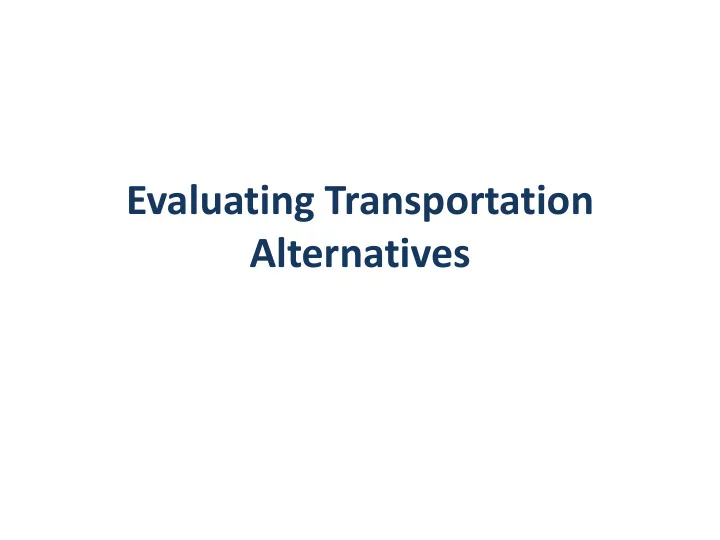

Evaluating Transportation Alternatives
EVALUATION BASED ON MULTIPLE CRITERIA Many problems associated with economic methods limit their usefulness. Among these are: • Converting criteria values directly into dollar amounts. • Choosing the appropriate value of interest rate and service life. • Distinguishing between the user groups that benefit from a project and those that pay. • Failing to distinguish between groups that benefit and those that lose. • Considering all costs, including external costs. Discusses evaluation methods that seek to include measurable criteria that are not translated just in monetary terms.
1. Rating and Ranking: Numerical scores are helpful in comparing the relative worth of alternatives in cases where criteria values cannot be transformed into monetary amounts.
2. Cost Effectiveness: • Attempts to be comprehensive in its approach while using the best attributes of economic evaluation. – The project criteria are considered to be measures of its effectiveness, and – The costs are considered as the investment required if that effectiveness value is to be achieved. – Data from economic analysis is used + measured environmental consequences
3. Evaluation of Completed Projects (1) how effective it has been in accomplishing its objectives, (2) what can be learned that is useful for other project decisions, (3) what changes should be made to improve the current situation, or (4) if the project should be continued or abandoned.
4. Evaluating Effects of Transportation on Social and Natural Systems Step 1: Assess the Need for the Project. Addresses the question: Why do it at all? That is, how does the proposed project advance the stated goals and objectives and does the project represent the best use of funds when compared with other options?
Step 2: Conduct a Feasibility Analysis of the Alternatives. Addresses the question: – Why do it this way? That is, has the project been demonstrated to be a feasible one – from an engineering perspective? What are the costs involved in the project? Are – there other methods or approaches that could achieve a similar result at a lower cost – in time and money? Should the project be included as a budget item for implementation or deferred to a later date?
Step 3: Analyze the Impact of the Project. Addresses the question: If the project is feasible, what will be its impact on affected groups? These include the users of the transportation improvement, the community, and other stakeholders who will be impacted by the construction of the project. These effects are categorized into three major effects. – Transportation system effects – Social and economic effects – Natural systems effects
Step 3 (a): Transportation System Effects. These are effects experienced by the travelers who use the transportation facility, such as motorists, transit riders, and commercial vehicles. They comprise the following elements. – Changes in travel time – Changes in safety – Changes in vehicle operating costs
Step 3 (b): Social and Economic Effects. These are analyzed to determine the impact that a transportation project could have on the community and its residents. These studies are also conducted to meet federal and state requirements regarding environmental impact, civil rights, and environmental justice. They comprise the following elements. – Accessibility – Community cohesion – Economic development – Traffic noise – Visual quality – Property values
Step 3 (c): Natural Systems Effects. These refer to those impacts of transportation projects that are related to the environment within which the project will be located. • Among the natural elements that may be affected are – Air and water quality – Endangered species – Wildlife – Greenhouse gas emissions – Archeological sites – Energy conservation – Areas of cultural or historic significance
Recommend
More recommend